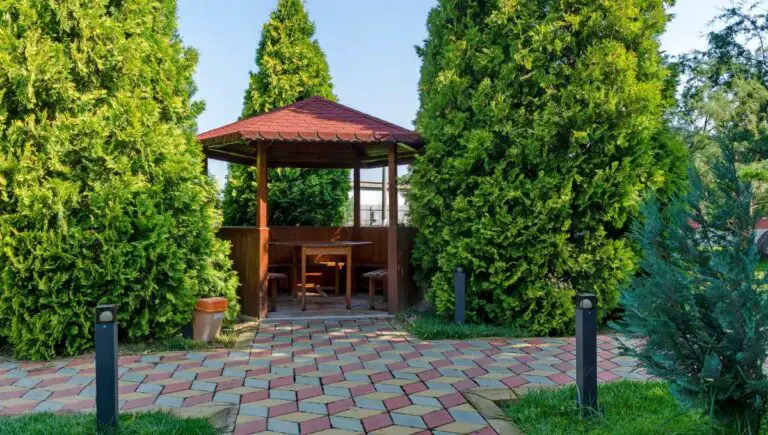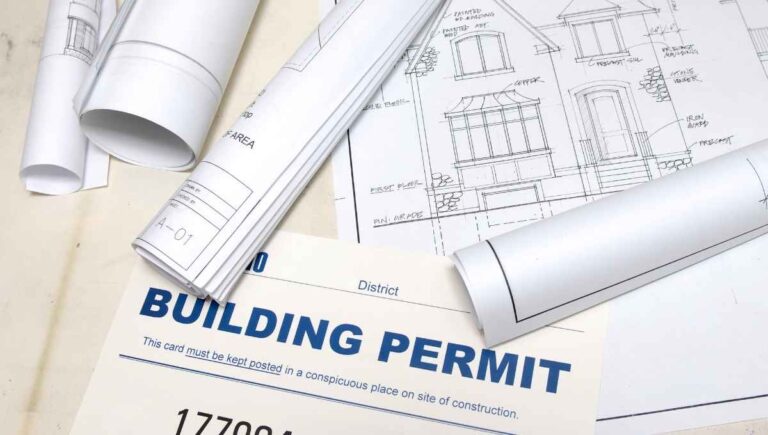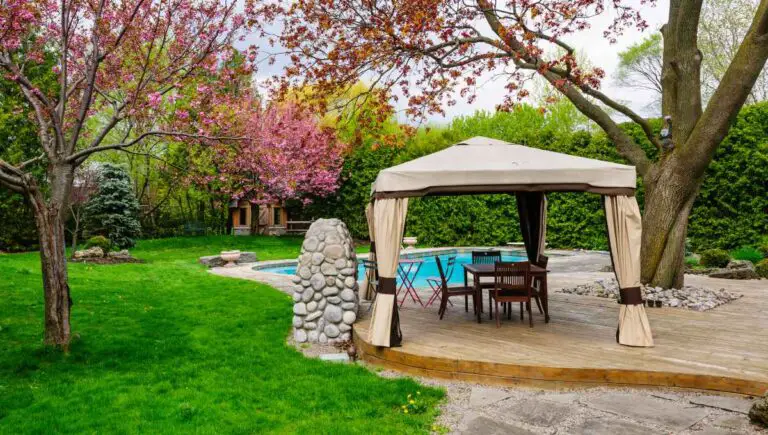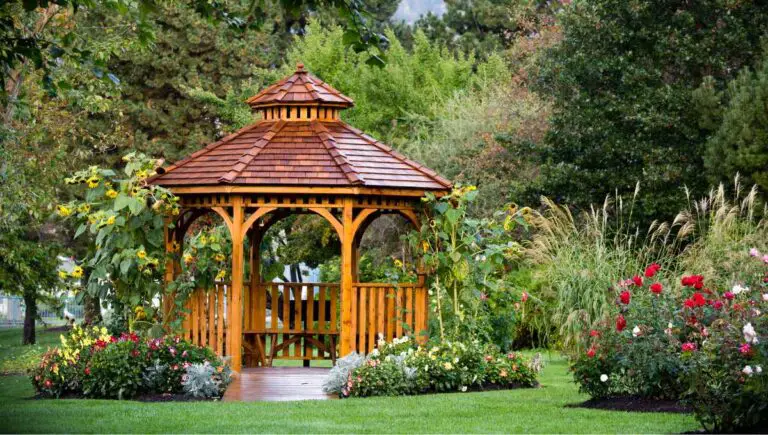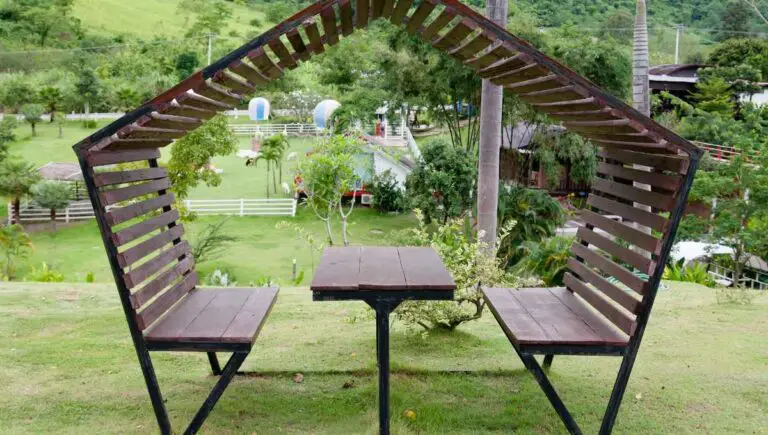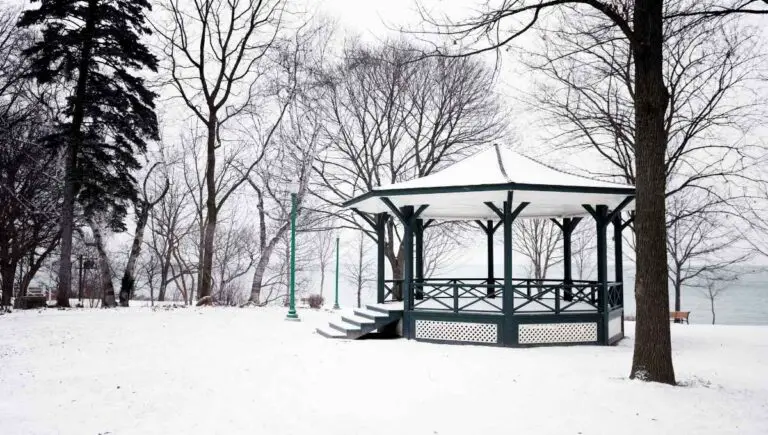Are Gazebos Permanent? (Best Portable & Permanent Options)

Gazebos are popular outdoor structures that provide shade and shelter. They can be made from a variety of materials, including wood, metal, and plastic, and come in a range of sizes and styles. However, a common question among homeowners is whether gazebos are permanent structures.
Some gazebos are designed to be permanent and are anchored to a concrete slab or deck. Others are designed to be portable and can be disassembled and moved to another location. The type of gazebo you choose will depend on your needs and preferences.
Whether your gazebo is permanent or temporary, each has its own advantages and disadvantages. In this article, we’re going to discuss the differences and best options for you to choose from.
This post contains affiliate links from Amazon and other stores. This means Yard Blogger may earn a commission if you make a purchase using any of our links. Please refer to our full affiliate disclosure policy for full details.
Here’s a Quick Pro Tip!
Whether you have a permanent or temporary gazebo, it’s always a good idea to reinforce your gazebo to ensure it’s safe to use. We also have a solution for you if you want to cover the sides of your gazebo.
Our favorite pics from Amazon:
1. Storm Straps – Ideal to reinforce your gazebo against strong winds.
2. Gazebo weights – Keeps your gazebo in place since they are quite lightweight.
3. Waterproof curtains – Perfect for privacy or ambiance.
Gazebos
Gazebos can be classified as a permanent or a temporary structure. The definition varies, depending on what the gazebo is made of and if you can move it around. Let’s discuss gazebos in more detail.
Should I Take My Gazebo Down?
If you don’t have a permanent gazebo that is anchored to the ground, you should take your gazebo down when you’re no longer using it. A gazebo can become an eyesore if it’s left for too long.
Pop-up gazebos are much more susceptible to wind and weather damage, so you should never leave them standing through winter. Also, if you’re planning on going away for a week or so, you should always take your gazebo down.
Is a Gazebo Automatically a Permanent Structure?
If your gazebo is made of wood, metal, or brick, it is considered a permanent structure. Camping gazebos that are made of canvas material are not considered permanent structures.
If you’re planning on building a gazebo in your backyard to last for many years, you would need to get a permit from your local municipality. It is considered a gazebo even if it has no walls.
Can You Leave a Pop-up Gazebo Up Forever?
You should not leave a pop-up gazebo up for an extended period of time. These gazebos are made up of less durable materials that usually only last a few years if you take good care of them.
When you leave your pop-up gazebo up indefinitely, you are constantly exposing the material of the gazebo to snow, wind, rain, sun, etc. This constant exposure drastically reduces the durability of your gazebo and you might be surprised how quickly you will start to see damage to your gazebo.
How Do You Put Down an All-Seasons Gazebo?
Take off any weights on the legs of the gazebo or any other reinforcements. Lower the legs of the pop-up gazebo to their lowest setting and loosen any straps tying the canopy to the frame.
When all the straps are loose, slowly start to pull off the canopy from the frame. Be careful not to tear your canopy on the frame. Fold up the canopy and place it in the storage bag. Pick up one leg at a time and push it towards each other. The frame should fold into itself.
Permanent Gazebos
Permanent gazebos are becoming more popular and new homeowners often look for homes with a permanent gazebo or a yard big enough to build a permanent gazebo. Let’s discuss some frequent questions about permanent gazebos.

Is There a Permanent Gazebo for a Deck?
Gazebos are available as a permanent structure. They can be placed on your deck or anywhere in your backyard. These permanent gazebos are usually made of wood, concrete, or metal.
These gazebos can be a focal point of a backyard while also providing shade during hot summer days. Although it is considered a structure, in most cases, you would need a permit to build a permanent gazebo in your backyard.
Is There a Permanent Gazebo With Sides?
Gazebos are usually installed without sides, but it is relatively easy to install side panels to your gazebo. If you have a wooden gazebo, you can add wood paneling to the sides for a sleek look.
Others prefer installing waterproof curtains for their gazebos. These can be installed onto any material and gives a modern look to your backyard. It’s relatively easy to install a curtain rod inside of your gazebo.
How to Install a Permanent Gazebo?
Using a contractor or a professional to install your gazebo is recommended. This is for safety reasons, to ensure that your gazebo is as safe as it can be for your family. It’s also best since professionals would be familiar with local building regulations.
You can expect to pay between $500 – $1000 on labor costs to get someone to install your gazebo. The price range differs according to the material and size of your gazebo.
Are Enclosed Gazebos Considered Permanent?
A gazebo is not considered permanent if it is enclosed. A permanent gazebo is a structure that is set up for an extended period of time. It’s usually made of wood, metal, or concrete. They are anchored in place and are built to withstand most weather conditions.
These permanent gazebos can be enclosed, or they can have open sides. The same can be said for a temporary pop-up gazebo, although these are usually made of vinyl or a canvas material — which is not as durable.
Do You Need Planning Permission for a Permanent Gazebo?
In the United States, you need a planning and building permit for any permanent structure. A permanent gazebo is seen as a structure; hence you need a permit to build a gazebo on your property.
You would not need a permit if your gazebo is smaller than 100 square feet, although this is a fairly small size, especially for a family. We would recommend talking to a local municipal officer to discuss the correct channels when building a gazebo.
Temporary Gazebos
Temporary gazebos are quite popular in families who go camping or to the beach often. It’s very convenient to carry around while being easy to put up and take down. Let’s discuss the details about installing and taking down a temporary gazebo.

How to Install a Temporary Gazebo?
The first and arguably most important step of installing a temporary gazebo is placement. You need to find a flat piece of land, and your gazebo should not stand on an angle. It’s also a good idea to install your gazebo near tall trees to block the wind.
Steps to install a temporary gazebo:
- Find a suitable and flat piece of land where the gazebo can be installed. Make sure it is out of the direct wind. The ground should be soft enough to hammer pegs into.
- Place the frame upright on your identified piece of land.
- Ask a friend to help you and gently start to pull on opposite sides of the frame and slowly walk backward.
- The legs will part with ease until it’s completely open. Do not increase the height of the legs yet. It’s easier to place the canopy on a low frame.
- Take the canopy, fold it open, and place it over the frame. There should be velcro strips or similar to tie the canopy to the frame and the legs.
- After you feel the canopy is secured and lined up correctly, push the slider on each leg up until you hear a ‘click.’
- If you’re happy with the shape of the canopy, start to extend the legs of the frame until you have the desired height. Don’t make your gazebo extremely tall if it’s a windy day.
- For extra security, you can add weights to the legs of your gazebo.
How to Take Down a Temporary Gazebo?
To take down a temporary gazebo, you should first make sure that everything underneath is cleared out. If you had chairs, blankets, or anything else underneath the gazebo, you should pack those away first.
Steps to take down a temporary gazebo:
- Make sure that everything has been cleared from under the gazebo.
- Take off any weights or pegs that you have attached to the legs of your gazebo.
- Reduce the length of the legs until the canopy is at chest level.
- Undo any velcro straps holding the canopy to the frame.
- Carefully remove the canopy from the frame. Your canopy could rip or be damaged if you are too rough with this step.
- Fold your canopy up and place it in the storage bag.
- Grab a friend and each grab two legs of the gazebo. Slowly start to walk toward each other. The frame should start to fold into itself.
- When the frame is folded, place it in the storage bag.
Can I Take My Gazebo Down and Put It Back Up?
Pop-up gazebos are known for their convenience. They are relatively easy to take down today and put up again tomorrow in a different spot. They are used at sports events, at the beach, or when camping.
Permanent gazebos are not quite the same. As the name suggests, they are permanent and cannot be taken down and put back up with ease. If you want to move your permanent gazebo it would take lots of time, effort and finances.
You might also enjoy our post on If a Gazebo Can be Used as a Carport
How to Install a Portable Gazebo?
To install a portable gazebo, you should find a flat piece of land that is out of the direct wind (if possible). Start by gently pulling on the legs of the frame to encourage it to fold open. If you have someone to help you, the set-up is much easier and quicker.
After the frame is open, take your canopy and drag it over the top of the frame. Be careful that it does not snare and tear on the frame. Secure the canopy in place with velcro straps and then extend the legs of the gazebo to your desired height.
How Do You Disassemble a Gazebo?
Disassembling a gazebo can be done within 15 minutes. Make sure everything is cleared out underneath the gazebo, then start to reduce the height of the legs. Your canopy should be about chest height.
Undo any velcro straps tying your canopy to the frame, and slowly pull it off the frame. Your canopy could be damaged during this step, so you should be extra careful. Fold up your canopy and get a friend to help you push the legs of the frame together.
Other Concerns
There are some other concerns that people often think about when looking at purchasing a portable gazebo. In this section, we’re going to look at some of these concerns to ease your mind.
Should I Take My Gazebo Down in Bad Weather?
Pop-up gazebos should definitely be taken down in bad weather. They are mainly designed to provide shade from the sun and cover from light rain. Do not leave your portable gazebo up during bad weather.
Most gazebos can withstand about 35 miles per hour wind speed. Anything more than that, you should take it down. Gazebos are also not designed for hail, snow, or extreme rain. Any extreme weather condition will most-likely damage your gazebo.
You might also enjoy our post on If Gazebos are Safe in the Wind
Can I Turn My Portable Gazebo Into a Permanent Structure?
Portable gazebos are made to be convenient and portable. However, they are not made of durable material. It will never have the same durability as a wooden/metal gazebo, but there are some ways to strengthen your portable gazebo.
The easiest and most effective way to strengthen your gazebo is to anchor it properly. This can be done by adding weights to the legs of your gazebo. Alternatively, you could use straps to hold down your gazebo.
How Do You Store a Gazebo?
A portable gazebo usually comes with a storage bag from its manufacturer. You should store this bag in a waterproof and cool area, like a shed or garage. This ensures that the gazebo will not be damaged while in storage.
Before storing your gazebo away for the winter, open the canopy and clean it thoroughly. All the mud and dirt that is on the canopy from the summer should be scrubbed off and cleaned before next summer.
Can You Use a Gazebo Year-Round?
A gazebo is not designed specifically for one season but can be used year-round. However, it can not be used in bad weather, like snow, heavy rain, or extreme wind conditions.
A gazebo can shelter you from a light rain shower and the scorching sun, but it won’t stand a chance in a hurricane. Also, the material of a pop-up gazebo is not very durable, so if you leave it up year round, you should expect some wear and tear.
Related Questions
How Much Does a Permanent Gazebo Cost?
Most permanent gazebos range between $5000 and $10000, although high-end structures can reach $20000. Although there are DIY gazebo kits that you can purchase and build your own gazebo for under $2000.
Gazebo kits like the Mellcom galvanized steel gazebo are popular among DIY enthusiasts and penny savers. It comes with instructions and guides, but many prefer trusting professionals to build their dream gazebo.
What Is the Best Heavy-Duty All-Season Gazebo?
No pop-up gazebo is truly all-season, since they are not durable to withstand extreme weather. Although certain gazebos are more durable than others, we would recommend the ABCCANOPY 13 x 13 pop-up gazebo.
This pop-up gazebo is shipped with storm straps, planting rods and mosquito nets. It’s a step up from an average pop-up gazebo while still being convenient and heavy-duty enough to use most of the time.
How Do You Move a Gazebo by Yourself?
To move a gazebo by yourself you should make sure that nothing is tying your gazebo to the ground. Remove all weights and storm straps attached to the legs, and decide where you want to move your gazebo.
Pop-up gazebos are made of lightweight material, so it is relatively easy to move around, even by yourself. Take one leg and pull it slowly. First, walk one or two feet and see if the whole gazebo is moving with you. If it is, you can continue walking until you reach the new spot.
Final Thoughts
To sum it up, gazebos that are fixed structures in your yard that can’t be packed away and carried around are permanent structures. Alternatively, a gazebo that can be packed up and put up within minutes is temporary.








